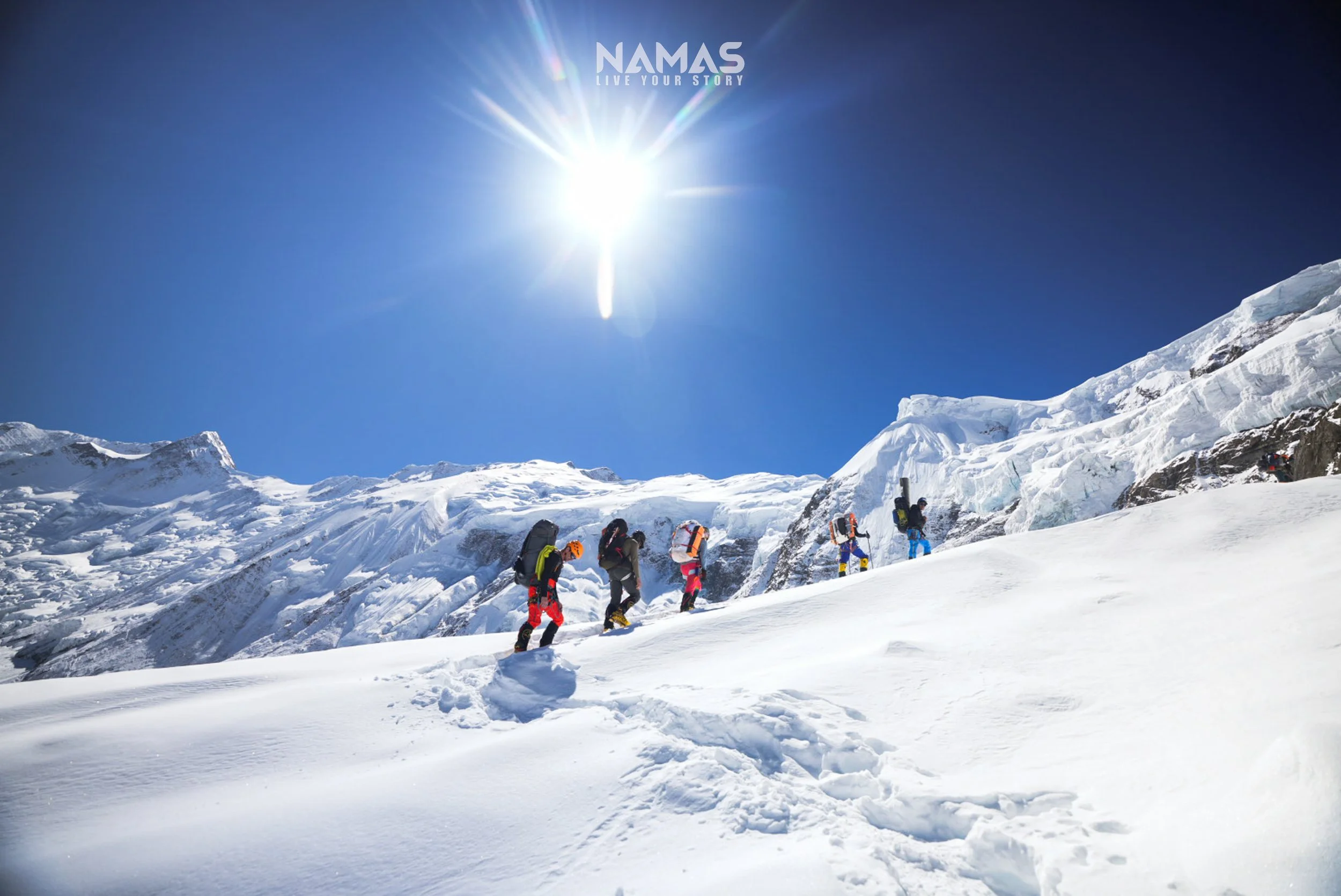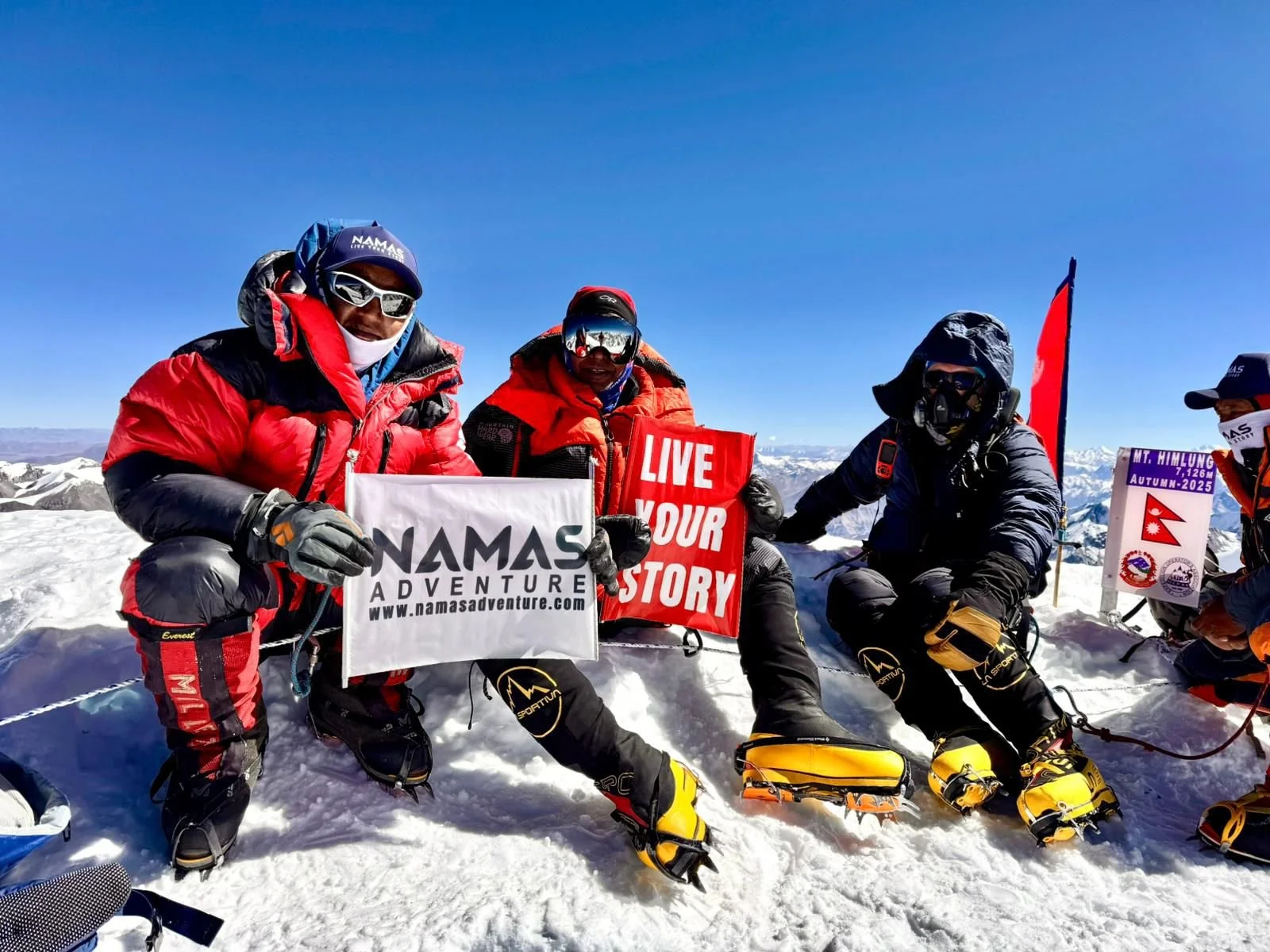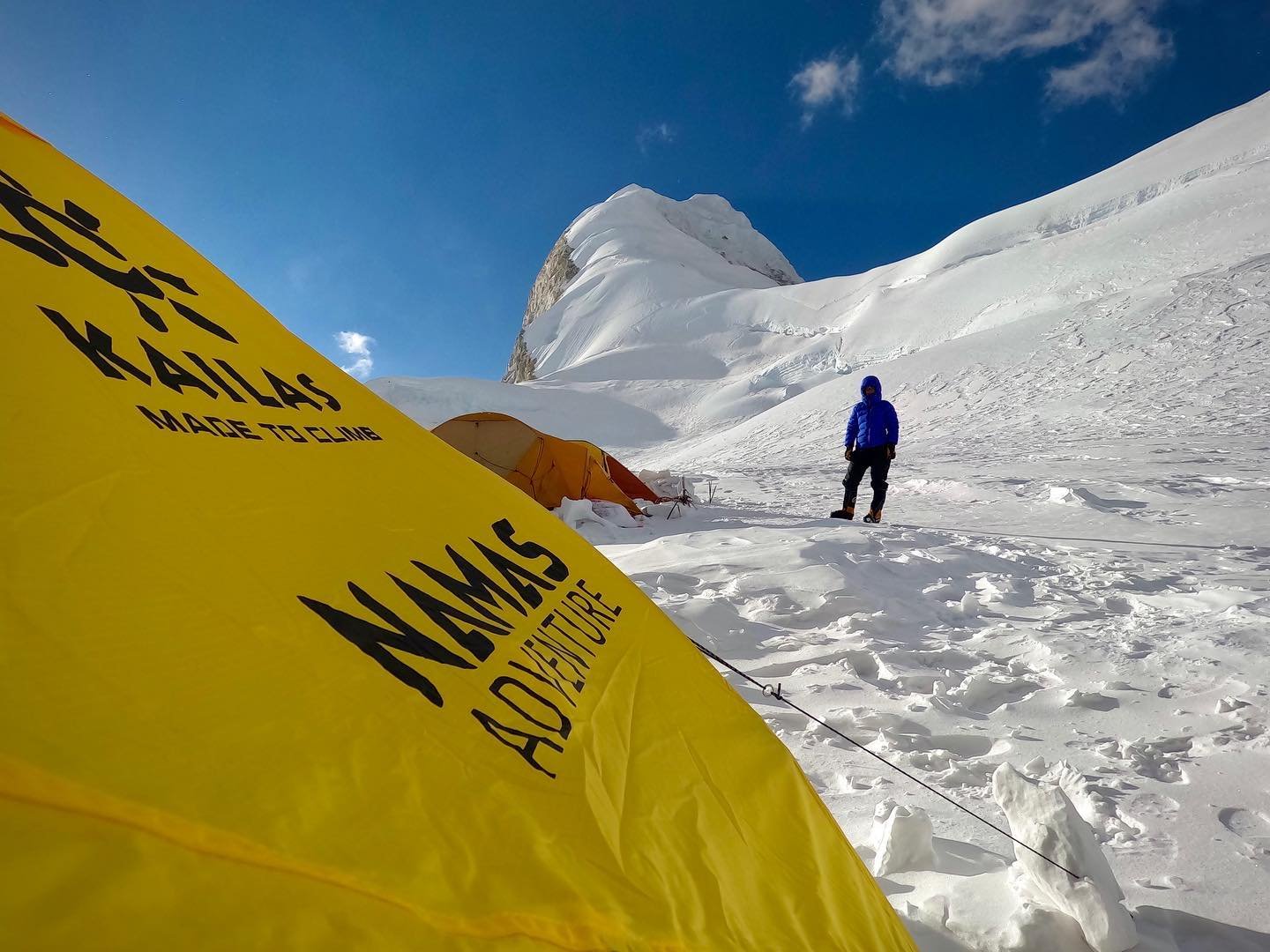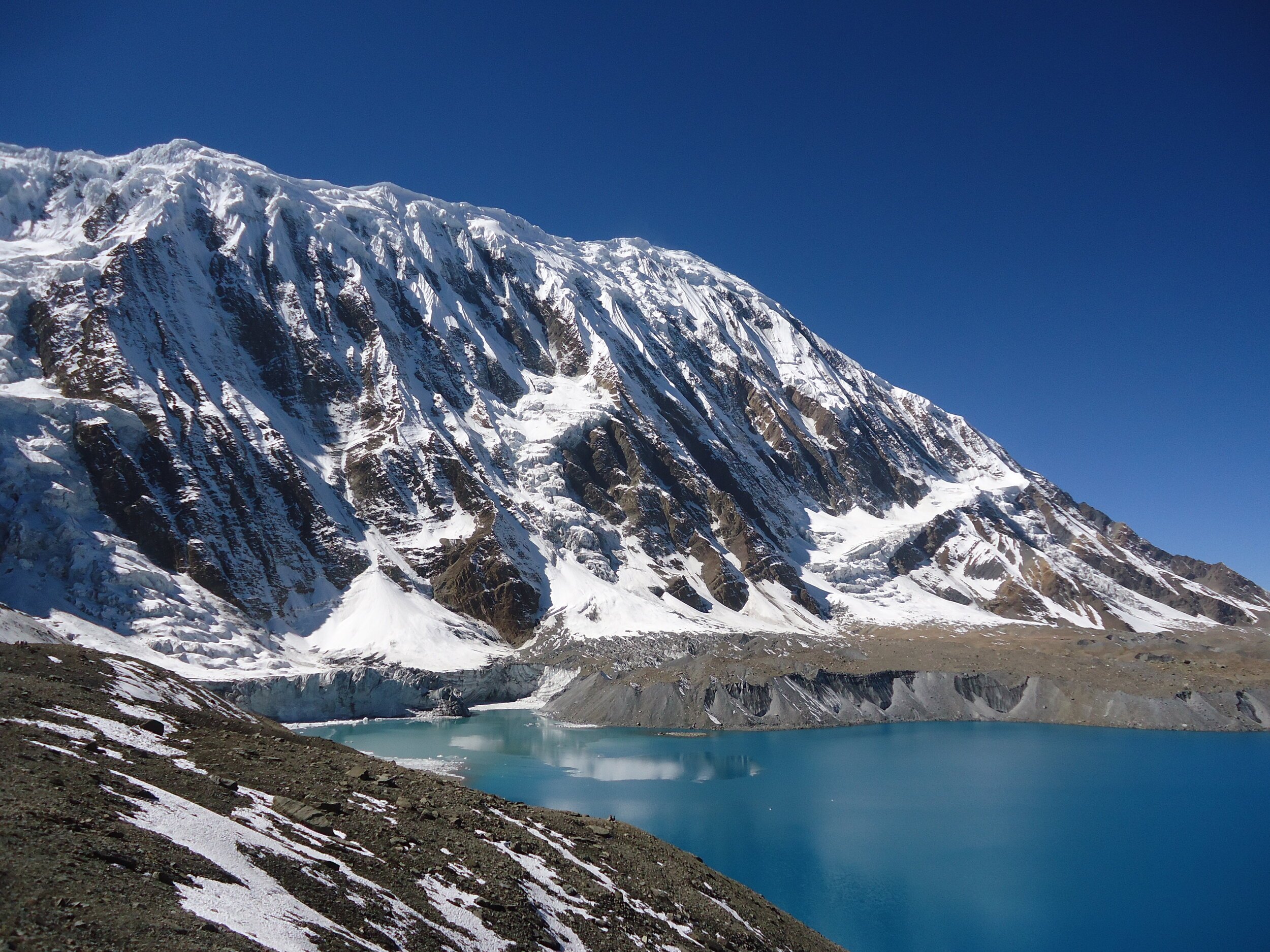Life Above Base Camp: What Every Climber Should Know Before finalizing a 7000m Peak
Life above Base Camp is harsher, colder, and more demanding. But with the right preparation, knowledge, and support, it’s also one of the most rewarding experiences a climber can have. At Namas Adventure, our goal is to help you understand exactly what to expect so you can climb with confidence.
Below, we break down the realities of high-altitude life and the systems that make a 7000m expedition successful
1. Base Camp: Your Recovery & Preparation Zone
Before going higher, you’ll spend a few days at Base Camp resting from the trek in. This is where your body begins adjusting to thinner air and where you perform equipment checks, skill training, meet your personal guides, and settle into a steady daily rhythm.
Base Camp is also the last place where you’ll enjoy relatively comfortable sleeping, bigger meals, and stable communication.
Once the team is fully rested, the acclimatization process begins.
2. Acclimatization Rotations
Rotations are the foundation of any successful 7000M expedition. They gradually expose your body to higher altitude, allowing you to adapt safely.
A Standard Rotation Looks Like:
Base Camp → Camp 1
Sleep one night.
Camp 1 → Camp 2
Sleep one night.
Camp 2 → Base Camp
Descend all the way down to base camp to recover.
Benefits - Each rotation strengthens your body’s ability to handle reduced oxygen levels.
Why Rotations Matter
Increases red blood cell production
Teaches your body to function with low oxygen
Helps you understand your personal altitude response
Allows you to store gear in higher camps to lighten the summit load
Once rotations are complete and weather improves, we prepare for the summit push.
3. Meals, Water, and Sanitation
Life becomes simpler—and much more physical—as you move above Base Camp. Every action you take, whether it’s eating, hydrating, or resting, is aimed at keeping your body strong enough to continue climbing higher.
Meals in High Camps
Food at high altitude needs to be lightweight, easy to prepare, and fuel-efficient. Meals typically include:
Porridge, oats, muesli
Instant noodles and soups
Nuts, biscuits
Freeze-dried meals
Energy bars and gels
Because food options above Base Camp are limited, if you have specific personal snacks or comfort foods, we highly recommend that you bring them from your home country or purchase them in Kathmandu before heading to the mountain. These familiar foods often provide a big mental and physical boost when climbing gets tough.
Water
All water in the higher camps is made by melting and boiling snow or ice. This process takes time and uses a considerable amount of fuel, so staying hydrated requires patience and discipline.
To prevent your water from freezing, you must use insulated bottles or a high-quality thermos. Even at night or during rest periods, keep your water inside your sleeping bag or close to your body to maintain warmth.
Sanitation
There are no toilet facilities in higher camps. All climbers use wag bags, and every bag must be carried back down to Base Camp. Waste is then properly disposed of in the designated Base Camp toilet area.
This system is important for:
Protecting the mountain environment
Preventing health issues
Keeping higher camps clean for all teams and keeping the mountain clean
At Namas Adventure, we strictly follow Leave No Trace principles, ensuring that the mountain remains pristine for future climbers and local communities.
4. Load Distribution: What You Carry vs. What We Carry
You Typically Carry:
Climbing boots, Climbing technical gears
Layers and sleeping bag
Snacks and water
Down suit or summit clothing
Sleeping pad
Personal essentials
If you prefer a lighter load, you can hire an assistant guide to carry your gear all the way up to the summit. Rules are different at Kyrgyzstan - Lenin Peak or Aconcagua expedition, please inquire with our team for more details.
Guides/Sherpas Carry:
Tents
Stoves and fuels
Group meals
Ropes, tools and hardware
Group supplemental oxygen and first aid
Heavy communal gear
During rotations, you can leave items at higher camps, reducing weight for the summit push.
5. Your Climbing Backpack: Why 60L - 70L Is the Ideal Size
A 60-70 liter pack is perfect for carrying:
Sleeping bag
Down suit and layers
Water, personal snacks, and personal items
Technical gear
Goggles, mitts, crampons
Oxygen (if applicable)
Using dry bags inside your pack keeps gear protected from snow and moisture.
6. boots required for 7000m climb
With better technologies, climbing shoes have improved every year. We highly recommend double-layered boots like Kailas Everest 8000M, La Sportiva Olympus Mons Cube, Scarpa 8000 phantom, Millet Everest summit GTX. It is wise to spend on good mountaineering boots, as so with all the gears that we have mentioned in this post above.
For your down suit and summit clothing, please refer to this link: Down Suit & Summit Gear – choosing the right layers is just as important as having the right boots.
Foot Care Tips:
Your feet are crucial for a safe and comfortable climb. Proper care can prevent blisters, frostbite, and discomfort.
1. Break in Your Boots Early
Wear your boots on long hikes or walks before the expedition to soften them and shape them to your feet. This prevents blisters and pressure points at high altitude.
2. Use a Sock System
A liner sock plus a thick summit sock reduces friction, wicks moisture, and provides insulation. Carry extra pairs to stay dry.
3. Account for Swelling
Feet swell at altitude. Choose boots with enough room for thick socks and swelling, or consider sizing up slightly.
4. Test Boots and Crampons
Practice walking and climbing with boots and crampons together before traveling. Proper fit saves discomfort and prevents accidents.
5. Keep Feet Warm and Dry
Warm feet are safe feet. Avoid tight lacing, use foot warmers if needed, and keep socks dry. Overnight, store boots inside your sleeping bag to maintain warmth.
7. How to Communicate on High-Altitude Expeditions
At most Base Camps, you’ll have either satellite phone or internet connections (2024/25 recent developments - Nepal) to stay in touch with family and friends. Base Camp is also equipped with solar panels and generators to charge mobile phones and other electronic devices.
Once the team moves above Base Camp, communication becomes more structured and essential for safety:
Satellite Phone: Your main guide carries a satellite phone, providing a direct line to our expedition office in Kathmandu. This is used for critical updates, including weather changes, logistical needs, or emergencies.
Two-Way Radios: All Sherpas carry radios (walkie-talkies) to maintain constant, real-time communication between camps — from Base Camp to higher camps. This ensures smooth coordination for supply movements, schedule adjustments, and rapid response to sudden weather or safety issues.
8. The Summit Push
After rotations and a few days of rest, the summit push begins—usually timed around the best weather window.
Typical Summit Push Schedule
Base Camp → Camp 1
Camp 1 → Camp 2
Camp 2 → Camp 3 (if the route requires it)
Some routes allow skipping Camp 3.Camp 2 or 3 → Summit → Descend to Camp 2 or Camp 1
Final descent to Base Camp
Why We Leave for the Summit at Midnight
Firmer snow
Lower avalanche risk
Calmer winds
More stable temperatures
Enough daylight for the long descent
What Summit Day Feels Like
It’s a long, slow, intensely focused effort with:
Steep slopes
Rope sections
Extreme cold
Very thin air requiring frequent breathing breaks
Supplemental oxygen is optional for many 7000M peaks, depending on climber preference.
Important note: Most climbers underestimate the descent — yet it’s often the most critical and dangerous part of the entire climb. After days of pushing uphill, your body is tired, your focus drops, and that’s when most accidents happen.
The descent is tedious, demanding, and requires just as much strength, awareness, and discipline as the ascent. You must be as strong coming down as you were going up.
9. Sleeping System
Nights above Base Camp are brutally cold. Your sleeping system must be reliable:
Expedition-grade down sleeping bag
Down suit or warm summit layers
Insulated sleeping pad(s) to block ground cold
10. Hydration, Nutrition & Mental Endurance
Hydration
Staying hydrated is critical at high altitude, as dehydration can worsen fatigue and increase the risk of altitude sickness. Drink regularly throughout the day, even if you don’t feel thirsty.
Nutrition
At altitude, your appetite often decreases, but your body requires high-calorie, easily digestible foods to maintain energy. Focus on:
Soups and instant noodles for warmth and quick energy
Energy bars and gels for on the go nutrition
Nuts, chocolates, and biscuits for concentrated calories
Freeze-dried meals when available
Plan to eat small amounts frequently rather than forcing large meals, as your digestive system slows down in thin air.
Mental Endurance
Life above Base Camp challenges not just the body but the mind. You will face:
Limited sleep due to altitude and cold
Harsh winds and sub-zero temperatures
Slow progress on steep or technical terrain
Long days with continuous physical and mental demands
11. Environmental Responsibility & Safety
Environmental Care
Pack out all trash
Carry down all human waste
Respect the local environment and culture
Safety
Understand altitude sickness symptoms
Weather changes quickly—follow your guide’s decisions
Carry personal medications and essentials
Communicate honestly with guides about how you feel
At Namas Adventure, your safety is always our top priority.
Climbing a 7000m peak is one of the most demanding and rewarding experiences in mountaineering. Life above Base Camp tests your strength, discipline, and mindset — but with the right preparation, guidance, and support system, it becomes a life-changing milestone rather than an overwhelming challenge.
At Namas Adventure, we’ve built our expedition approach around safety, smart acclimatization, experienced Sherpa support, and clear communication from Base Camp to the summit. Whether you aim to gain high-altitude experience, prepare for future 8000m climbs, or push your personal limits, our 7000m expeditions offer the perfect foundation.
Each mountain carries its own character — from technical challenges to less-crowded routes — giving climbers a chance to grow, learn, and experience the raw beauty of the Himalayas and Central Asia.
If your goal is to climb higher, prepare for an 8000m expedition, or take on a major high-altitude challenge, a 7000m climb is the step that transforms you.
When you’re ready to take that step, we’re here to guide you — safely, confidently, and with purpose.
Live Your Story
7000M and 8000M expedition 2025 departures - Namas Adventure
Planning your next high-altitude adventure? Namas Adventure's 2025 departures for 7000M and 8000M peaks cater to climbers of varying skills, from entry-level enthusiasts to advanced level climbers. For more detailed information about each expedition, please click on the expedition name.
7000M
Entry Level
Perfect for climbers with basic technical skills and a good fitness level. Climbers must have experience at altitudes over 5000M - 6000M and are looking to push their limits further:
Intermediate Level
Ideal for those with some high-altitude experience, good technical skills, and fitness level.
Advanced Level
Suitable for climbers with advanced skills and experience.
8000M
Entry Level
For climbers with intermediate technical skills and great fitness. Must have previous experience at altitudes over 6000M, including at least one 7000M peak.
Advanced Level
The ultimate test for top-tier climbers, requiring advanced technical knowledge and peak physical fitness.
Whether you're looking to step up your climbing game or tackle the world's highest peaks, Namas Adventure has an expedition for you. Join us to reach beyond the clouds and achieve the extraordinary in 2025.
Inquire here
Namas Adventure Team
LIVE YOUR STORY
Intermediate level 7000M+ Mountaineering Expeditions - Namas Adventure
In this article, we aim to introduce you to the thrilling world of 7000-meter intermediate-level expeditions. These remote climbs offer a unique blend of adventure, challenge, and joy, with fewer summits compared to their higher counterparts. A perfect mission for intermediate-level climbers, these expeditions provide an exciting opportunity to push your limits and conquer towering peaks. While 7000-meter peaks may not boast the same bragging rights as 8000-meter summits, they offer a special experience for those who seek pure joy in thin-air alpine challenges and push themselves to extreme altitudes. Whether you're testing your skills or simply marveling at the wonders of nature, embarking on a 7000-meter expedition promises an exhilarating journey filled with excitement and achievement. Below, we'll explore some of the best intermediate-level 7000M peaks that we've had the privilege of exploring, providing you with valuable information to help you plan your next adventure. We look forward to the opportunity to serve you on any expedition you choose to embark on.
Note - We will continue to expand and update our list of peaks as we explore more 7000-meter peaks in the years to come.
First on the list for intermediate 7000-meter-plus peak is Mount Baruntse. Standing at 7129 meters, Baruntse is conveniently located between the Khumbu region and the towering peak of Makalu (8646m). Mera Peak (6476m) serves as an excellent acclimatization peak before tackling Baruntse, and it can also be accessed via the Ampahu Lhabtas pass (5800m). The climb itself involves setting up two high alpine camps, with relatively fewer objective dangers, offering climbers a high success rate. Most successful summit attempts occur during the autumn season climb.
Pre-requisite requirements include climbing experience on peaks such as Lobuche East and Island Peak, Chulu West, Khumbu Three Peaks or Annapurna Three Peaks, Alpamayo, Mont Blanc, Zermatt, or other similar-grade mountains. These experiences will help prepare climbers for the challenges of Mount Baruntse.
Be ready for a very cold base camp.
Tilicho Peak, standing at an impressive 7134 meters, presents a thrilling yet fulfilling challenge for climbers seeking technical ascents in the 7000-meter peak range. The journey begins with a scenic trek through the Annapurna circuit, leading to the stunning Tilicho Lake, the highest lake in the world at an elevation of 4910 meters.
Located north of Manang in the Annapurna Region, Tilicho Peak boasts a majestic northeast ridge covered in snow, offering panoramic views of the high Kali Gandaki valley to the west and the Marshyangdi Valley to the east. Nearby lies the mystical land of Mustang to the north.
To undertake this adventure, climbers should meet certain prerequisites, such as experience on peaks like Alpamayo, Khumbu Three Peaks, or Annapurna Three Peaks, Himlung Himal and have mixed climbing grade 2-3 or ice climbing experience WIII-IV.
The standard climbing route follows the northwest shoulder, with Base Camp situated at 4800 meters at the lake's northwest end. With fewer climbers in the Annapurna mountain range, adventurers can enjoy the breathtaking landscape almost exclusively to themselves.
KHAN TENGRI 7439M
Khan Tengri 7439M, is located in Kazakhstan (highest peak). This breathtaking mountain falls on the Tien Shan mountain range of Central Asia (boundaries between Kazakhstan, Kyrgyzstan, and the Uygur Autonomous Region of Xinjiang, China), Khan Tengri offers an exhilarating challenge for intermediate climbers seeking an unforgettable adventure.
Pre-requisite requirements for this expedition include, Lobuche East & Island Peak, Khumbu 3 Peak or Annapurna 3 Peak, Alpamayo, Himlung Himal or expeditions with similar grades
Climbing Khan Tengri presents a unique set of challenges, blending technical skill with physical endurance. This expedition is also known for gaining altitude rapidly and objective dangers of avalanches are higher too making it one of the peaks with at least 7000M summits with the amount of climbers at the peak each season. Aspiring climbers should expect to navigate steep slopes, crevasses, and changing weather conditions. The weather in Khan Tengri is known for its notorious nature and is unpredictable, with temperatures dropping drastically and strong winds posing additional obstacles. However, with proper preparation and guidance, climbers can overcome these challenges and reach the summit.
Conclusion
Embarking on a 7000-meter intermediate expedition is a journey filled with challenge, adventure, and personal growth. Each of these peaks presents formidable sets of mixed challenges, combining technical prowess with classic mountaineering skills, all while demanding both physical and mental resilience. From the towering peaks of Baruntse to the technical ascents of Tilicho Peak, every expedition offers climbers the opportunity to push their limits and conquer remarkable heights.
As we continue to explore more peaks and expand our experiences, we eagerly anticipate sharing more adventures with you. Whether you're drawn to the thrill of high-altitude climbing or simply captivated by the beauty of the world's tallest mountains, there's an expedition waiting for you.
We embark on select peaks yearly and would be honored to have the chance to take you on one of these remote and less summited expeditions. Together, we can create unforgettable memories and face the challenge of the mountains, discovering just how far you can push yourselves and leveling up for even greater adventures. Dream big, prepare diligently, and let's make this climb together.
Let's go, LIVE YOUR STORY
Best 7000M+ peaks to climb in Nepal - Namas Adventure
Near the summit of Annapurna IV 7525M
Although 7000M peaks do not have the same level of prestige as 8000M peaks or the highest peaks in the world, they can still be a great challenge for adventure seekers. While these peaks may not be as well-known as their higher counterparts, they offer a unique and rewarding experience for climbers. 7000-meter peaks are ideal for those who are seeking a true adventure challenge, and who are motivated by a love of climbing, cultural immersion, and personal accomplishment. If you are one of these passionate climbers, consider embarking on a mountaineering expedition to one of the six 7000er peaks in Nepal listed in this post. These peaks offer a chance to push your limits and achieve something truly remarkable.
Below we have listed 6 amazing and remote peaks to climb in the Nepalese Himalayan range.
Note - Prior experience of alpine or mountaineering climb above 4000+M - 6000M+ is a must. Skill and fitness requirements will vary from different mountain peak objectives.
1. Himlung Himal 7126M (Least difficult & least technical 7000er)
Altitude: 7126M / 23,379ft
Climbers’ experience level: Intermediate/Advanced
Crowd level: Minimum (Spring, 5-20), Moderate (Autumn, 50 - 150)
Location: Annapurna Region
When to climb?: September - October
Duration: 30 Days
Difficulty grading: AD+/4 (Alpine/Fitness grading info)
Accommodation: Lodges and Base camp, Camp 1/2/3
Himlung Himal, standing at 7126 meters, is widely considered to be one of the safest and easiest 7000 meter peaks to climb in Nepal. Thanks to new, safer routes pioneered by French and Swiss climbers, Himlung Himal may become more accessible to climbers seeking a less technically demanding experience in western Nepal. The peak was not climbed until 1992, when it was conquered by a Japanese expedition, due to the fact that the area was not open to foreigners until the early 1990s. Located between the Manaslu and Annapurna ranges, the base camp for Himlung Himal is set up at an elevation of 4900 meters. The previous route up the peak, via the northwest ridge, has become increasingly prone to avalanche danger. A new, normal route was pioneered in 2013 by Kari Kobler of Switzerland, which offers an interesting and relatively short climb with limited objective danger. This route ascends the south flank of the northwest ridge to reach the upper crest, bypassing the previous route.
Note - Himlung Himal 7126M has the most successful summit records amongst all the 7000M+ commercial expeditions in Nepal. (Himalayan Database)
The Himlung Himal climbing expedition involves establishing 2-3 high camps at elevations of 5430 meters, 6000 meters, and 6300 meters. The summit day involves an ascent of 1100 meters through snow slopes with an angle of 40-45 degrees, requiring good snow conditions. Deep snow can pose a challenge even for strong teams. The climb is technically simple and objectively safe, making it an ideal preparation for your first 8000 meter peak.
History: First Ascent by the Japanese team in 1992.
Climb - Himlung Himal Link
2. Baruntse Peak 7129M (intermediate level and demanding)
Altitude: 7129M/ 23,389 ft
Acclimatization peak: Mera Peak 6476M
Climbers experience level: Intermediate level Experience
Crowd level: Minimum (Autumn, 15 - 40 climbers)
Location: Makalu Barun National Park
When to climb?: March-May or September - November
Duration: 32 - 35 Days
Difficulty Grading: D/ 4 (Alpine/Fitness grading info)
Accommodation: Lodges and Camping at Mera Peak/Baruntse BC/Camp 1 - 2
The Baruntse 7129M and Mera Peak 6476M climbing expedition offers a challenging and rewarding experience at the 7000 meter level. Baruntse, standing at 7129 meters, is located between Lhotse and Makalu, with other Himalayan peaks stretching out on either side. Teams often climb the nearby Mera Peak (6476 meters/21,246 feet) as an acclimatization climb, which falls on the same route as Baruntse. Once the base camp is established and the team has undergone training and a Puja ceremony, the real climb begins. Baruntse involves semi-technical climbing on steep slopes of 60 - 70 degrees incline to Camp 1 at 6000M via west col. The second camp is located at 6420 meters. Both camps are set up in exposed areas and are prone to high winds, so climbers should be prepared for unexpected weather conditions. The climbing route consists mainly of ice and snow, with very little rocky terrain after the first camp. Crevasses may appear more during the spring season compared to autumn along the route, and the objective at around 6900 meters can be dangerous. Experienced guidance is recommended in order to safely navigate the route to the summit.
History: Baruntse was first climbed on May 30, 1954 via the south ridge by Colin Todd and Geoff Harrow of a New Zealand expedition led by Sir Edmund Hillary.
Climb - Baruntse with Mera Peak Expedition link
3. Annapurna IV 7525M (advanced level, technical & physically demanding)
Altitude: 7525M / 24,688ft
Climbers experience level: Intermediate+/Advanced
Crowd level: Minimum (Spring/Autumn, 0 - 20)
Location: Annapurna Region
When to climb?: September - October
Total no of days: 33 Days
Difficulty grading: TD+/4 (Alpine/Fitness grading info)
Accommodation: Lodges and Base camp, Camps 1/2/3/4
Annapurna IV 7525M, is a great mountaineering objective for climbers looking for a challenging, but relatively safe and semi-technical climb. At 7527 meters, it is part of the Annapurna massif range and is located between Annapurna II and Annapurna III. While it may not be as popular as other peaks in the region, it offers fewer objective dangers and is considered the least technical of the Annapurna massif peaks (Annapurna I, II, III, IV, and Gangapurna). This mountain is not climbed as often as other peaks in the region.
History: Annapurna IV was first climbed in 1955 by a German expedition led by Heinz Steinmetz via the North Face and Northwest Ridge.
4. Tilicho Peak 7134M (intermediate level and remote climb)
Tiicho Peak 7134M.
Altitude: 7134M / 23,405ft ft
Climbers experience level: Intermediate to advanced
Crowd level: Minimum (Spring/autumn, 0-10 members)
Location: Annapurna Region
When to climb?: September - October-November
Total no of days: 32 Days
Difficulty grading: D+/4 (Alpine grading info)
Accommodation: Lodges and Basecamp, Camps 1/2/3
If you're seeking a technical challenge at the 7000M level, Tilicho Peak may be the climb for you. The expedition starts with a beautiful trek through the Annapurna circuit, culminating in a visit to Tilicho lake, the highest lake in the world, at an elevation of 4910 meters. Located in the Annapurna region of Nepal to the north of Manang, Tilicho Peak stands at a majestic 7134 meters. Its northeast ridge, covered in snow, towers over the Kali Gandaki valley to the west and the Marshyangdi Valley to the east, with the hidden kingdom of Mustang just a few miles to the north. The standard climbing route for the peak is the northwest shoulder, with the base camp located at 4910 meters on the northwest end of the lake.
Tilicho Peak is a technical climb that requires proficiency in climbing skills and physical fitness. It is recommended that climbers have previous experience in alpine and high-altitude climbing. The peak is graded as 4D, with a combination of rock and ice climbing, as well as glaciers. There are three high camps established on the route to the summit of Tilicho Peak. The climb from the base camp to Camp 1 at 5800 meters is straightforward, along a 50-degree mixed rock and ice route that is 590 meters in length. Camp 2, at 6200 meters, is located on the shoulder and can be accessed via a 55-degree snowfield that is 450 meters in length. The shoulder has an angle of 55 degrees and an 800-meter snowfield, with low objective danger and minimal exposure due to the wide width of the shoulder. Fixed ropes are required for the 40-degree slope to reach Camp 2 at 6300 meters. The summit is approached by climbing stretches of a 60-degree slope.
History: The first ascent was made in 1978 by the French climber Emanuel Schmutz using the northwest shoulder.
Climb - Tilicho Peak (Click here)
5. Putha Hiunchuli 7246M (Dhaulagiri VII) (least difficult and least technical. Remote 7000er)
Putha Hiunchuli (Dhaulagiri VII) 7246M, Photo by - Nunatak
Altitude: 7,246M / 23773ft
Difficulty: Least difficult and least technical
Crowd level: Minimum (Autumn, 5 - 20)
Location: Dhaulagiri Range
When to climb?: September - October
Total no of days: 31 Days
Difficulty grading: AD+/4 (Alpine grading info)
Accommodation: Lodges and Basecamp, Camp 1/2/3
Dhaulagiri VII (also known as 'Putha Hiunchuli') is one of the most accessible 7000M+ peaks in the Dhaulagiri range. It is located in the remote Dolpo or the wild west region of Nepal. Although most of the 7000M+ peaks are in remote corners of Nepal, this region even to locals is remotest compared to other regions of Nepal.
The climbing route has no significant technical climbing, the mountain is still a serious undertaking and provides excellent training for those who want to attempt Everest or other 8,000m peaks. Teams will be setting up three high altitude camps and a base camp. This can be considered as one of the easy climbs when we compare it amongst other 7000M peaks yet it is not to be underestimated. If you want to add an extra thrill then climbers with off-piste ski experiences can attempt a ski when descending.
History: This peak was first climbed by J.O.M Roberts and Ang Nima Sherpa in 1954.
Climb - Putha Hiunchuli (Dhaulagiri VII) Click here
6. Ama Dablam 6819M (advanced level & technical climb)
Altitude: 6,812M / 22,349ft
Acclimatization: Island peak 6180M
Climbers experience level: Advanced/Pro Level
Crowd level: Minimum (Spring, 5 - 20), Excessive (Autumn, 200 - 300) Mid October - Mid November is the busiest.
Location: Khumbu Region
When to climb?: September - November
Total no of days: 30 Days
Difficulty grading: TD+/5 (Alpine/Fitness grading info)
Accommodation: Lodges and Cam / Camping Island Peak BC/Highcamp/ Ama Dablam BC / Camp 1-2 and Camp 2.1 (depending on yearly climbing assessment)
Ama Dablam, standing at 6,856 meters, may not be as tall as some of the other 7000M peaks, but it is no less challenging. In fact, it is considered to be just as difficult as many of the 7000-meter peaks and is a must-do for alpine and mountain climbing enthusiasts. The combination of rock, snow, and ice climbing, along with exposed terrain and sections of almost 90-degree slopes, makes this peak a true test of skill and endurance. It is also known for its beauty and is highly sought after by even seasoned Everest summiteers. If you are looking for a thrilling and challenging mountain climbing experience, Ama Dablam is the peak for you.
Expedition teams normally utilize Island peak 6189M as an acclimatization peak before settling down at Ama Dablam base camp. The peak attracts a lot of climbers during the autumn season, rightly so because of its climbing nature. This expedition involves a cultural trek into the base camp and climbing on technical rock, vertical snow and ice routes and stunning exposed panoramic views of Everest, Lhotse, and Makalu from the summit. Teams climb Amadablam via the South West ridge, a technical route, and the standard route setting up 2 or possibly 3 camps (camp 3 depends on the assessment by each year’s rope fixing team). The route on the summit day is on steep snow and ice slopes, with outrageous exposure directly to the summit.
History: Ama Dablam was first summited on 13th March 1961, a Silver hut scientific expedition lead by Sir Edmund Hillary.
Climb - Ama Dablam with Island Peak Expedition (Link)
If you're looking to add some incredible mountain climbing experiences to your repertoire, consider tackling one of the 7000M+ peaks. Whether you're looking to build up to climbing even higher or just want the thrill of a mountaineering expedition, the peaks listed above offer some of the best mountain climbing adventures in the world. Located in remote areas and reaching high altitudes, each of these peaks has its own unique character and climbing challenges. We hope that these 7000M+ peaks will receive the recognition they deserve and that Nepal will continue to welcome mountain climbers from around the globe.
If you have any questions then there are some peaks like Baruntse, Ama Dablam, Tilicho Peak, Himlung Himal, and Annapurna IV expedition. We at Namas organize yearly departures but for other peaks such as Putha Hiunchuli, and Gangapurna upon inquiry our team will be able to organize a fully serviced expedition.
Go. Dare greater things.
Live Your Story.
Other related articles:


















